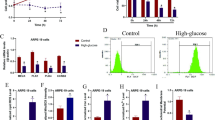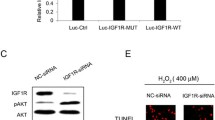Abstract
The degeneration of retinal pigment epithelium (RPE) cells in the sub retinal pigment epithelial space and choroid is an initial pathological characteristic for the age-related macular degeneration which is the leading cause of severe vision loss in old people. Moreover, oxidative stress is implicated as a major inducer of RPE cell death. Here, we assessed the correlation between the H2O2-induced RPE cell death and glutamine metabolism. We found under low glutamine supply (20 %), the ARPE-19 cells were more susceptive to H2O2-induced apoptosis. Moreover, the glutamine uptake and the glutaminase (GLS) were suppressed by H2O2 treatments. Moreover, we observed miR-23a was upregulated by H2O2 treatments and overexpression of miR-23a significantly sensitized ARPE-19 cells to H2O2. Importantly, Western blotting and luciferase assay demonstrated GLS1 is a direct target of miR-23a in RPE cells. Inhibition of the H2O2-induced miR-23a by antagomiR protected the RPE cells from the oxidative stress-induced cell death. In addition, recovery of GLS1 expression in miR-23a overexpressed RPE cells rescued the H2O2-induced cell death. This study illustrated a mechanism for the protection of the oxidative-induced RPE cell death through the recovery of glutamine metabolism by inhibition of miR-23a, contributing to the discovery of novel targets and the developments of therapeutic strategies for the prevention of RPE cells from oxidative stress.






Similar content being viewed by others
References
Ambati J, Fowler BJ (2012) Mechanisms of age-related macular degeneration. Neuron 75:26–39
Ratnapriya R, Chew EY (2013) Age-related macular degeneration-clinical review and genetics update. Clin Genet 84:160–166
Ambati J, Atkinson JP, Gelfand BD (2013) Immunology of age-related macular degeneration. Nat Rev Immunol 13:438–451
Gorbatyuk M, Gorbatyuk O (2013) Retinal degeneration: focus on the unfolded protein. Mol Vis 19:1985–1998
Ishikawa K, Kannan R, Hinton DR (2015) Molecular mechanisms of subretinal fibrosis in age-related macular degeneration. Exp Eye Res 142:19–25
Khandhadia S, Lotery A (2010) Oxidation and age-related macular degeneration: insights from molecular biology. Expert Rev Mol Med 12:e34
Beatty S, Koh H, Phil M, Henson D, Boulton M (2000) The role of oxidative stress in the pathogenesis of age-related macular degeneration. Surv Ophthalmol 45:115–134
Sasaki M, Ozawa Y, Kurihara T, Kubota S, Yuki K, Noda K, Kobayashi S, Ishida S, Tsubota K (2010) Neurodegenerative influence of oxidative stress in the retina of a murine model of diabetes. Diabetologia 53:971–979
Sanvicens N, Gómez-Vicente V, Masip I, Messeguer A, Cotter TG (2004) Oxidative stress-induced apoptosis in retinal photoreceptor cells is mediated by calpains and caspases and blocked by the oxygen radical scavenger CR-6. J Biol Chem 279:39268–39278
Ameres SL, Zamore PD (2013) Diversifying microRNA sequence and function. Nat Rev Mol Cell Biol 14:475–488
Croce CM (2009) Causes and consequences of microRNA dysregulation in cancer. Nat Rev Genet 10:704–714
Bartel DP (2004) MicroRNAs: genomics, biogenesis, mechanism, and function. Cell 116:281–297
Kutty RK, Samuel W, Jaworski C, Duncan T, Nagineni CN, Raghavachari N, Wiggert B, Redmond TM (2010) MicroRNA expression in human retinal pigment epithelial (ARPE-19) cells: increased expression of microRNA-9 by N-(4-hydroxyphenyl) retinamide. Mol Vis 16:1475–1486
Hou Q, Tang J, Wang Z, Wang C, Chen X, Hou L, Dong XD, Tu L (2013) Inhibitory effect of microRNA-34a on retinal pigment epithelial cell proliferation and migration. Invest Ophthalmol Vis Sci 54:6481–6488
Gao P, Tchernyshyov I, Chang TC, Lee YS, Kita K, Ochi T, Zeller KI, De Marzo AM, Van Eyk JE, Mendell JT, Dang CV (2009) c-Myc suppression of miR-23a/b enhances mitochondrial glutaminase expression and glutamine metabolism. Nature 458:762–765
Kim MH, Chung J, Yang JW, Chung SM, Kwag NH, Yoo JS (2003) Hydrogen peroxide-induced cell death in a human retinal pigment epithelial cell line, ARPE-19. Korean J Ophthalmol 17:19–28
Boulares AH, Yakovlev AG, Ivanova V, Stoica BA, Wang G, Iyer S, Smulson M (1999) Role of poly(ADP-ribose) polymerase (PARP) cleavage in apoptosis. Caspase 3-resistant PARP mutant increases rates of apoptosis in transfected cells. J Biol Chem 274:22932–22940
Kaufmann SH, Desnoyers S, Ottaviano Y, Davidson NE, Poirier GG (1993) Specific proteolytic cleavage of poly(ADP-ribose) polymerase: an early marker of chemotherapy-induced apoptosis. Cancer Res 53:3976–3985
Yao J, Bi HE, Sheng Y, Cheng LB, Wendu RL, Wang CH, Cao GF, Jiang Q (2013) Ultraviolet (UV) and hydrogen peroxide activate ceramide-ER stress-AMPK signaling axis to promote retinal pigment epithelium (RPE) cell apoptosis. Int J Mol Sci 14:10355–10368
He Y, Leung KW, Ren Y, Pei J, Ge J, Tombran-Tink J (2014) PEDF improves mitochondrial function in RPE cells during oxidative stress. Invest Ophthalmol Vis Sci 55:6742–6755
Yang D, Elner SG, Lin LR, Reddy VN, Petty HR, Elner VM (2009) Association of superoxide anions with retinal pigment epithelial cell apoptosis induced by mononuclear phagocytes. Invest Ophthalmol Vis Sci 50:4998–5005
Kook D, Wolf AH, Yu AL, Neubauer AS, Priglinger SG, Kampik A, Welge-Lüssen UC (2008) The protective effect of quercetin against oxidative stress in the human RPE in vitro. Invest Ophthalmol Vis Sci 49:1712–1720
Zeitz O, Schlichting L, Richard G, Strauss O (2007) Lack of antioxidative properties of vitamin C and pyruvate in cultured retinal pigment epithelial cells. Graefes Arch Clin Exp Ophthalmol 245:276–281
Schimel AM, Abraham L, Cox D, Sene A, Kraus C, Dace DS, Ercal N, Apte RS (2011) N-acetylcysteine amide (NACA) prevents retinal degeneration by up-regulating reduced glutathione production and reversing lipid peroxidation. Am J Pathol 178:2032–2043
Shanware NP, Bray K, Eng CH, Wang F, Follettie M, Myers J, Fantin VR, Abraham RT (2014) Glutamine deprivation stimulates mTOR-JNK-dependent chemokine secretion. Nat Commun 5:4900
Hensley CT, Wasti AT, DeBerardinis RJ (2013) Glutamine and cancer: cell biology, physiology, and clinical opportunities. J Clin Invest 123:3678–3684
Matés JM, Pérez-Gómez C, Núñez de Castro I, Asenjo M, Márquez J (2002) Glutamine and its relationship with intracellular redox status, oxidative stress and cell proliferation/death. Int J Biochem Cell Biol 34:439–458
Dumaswala UJ, Zhuo L, Mahajan S, Nair PN, Shertzer HG, Dibello P, Jacobsen DW (2001) Glutathione protects chemokine-scavenging and antioxidative defense functions in human RBCs. Am J Physiol Cell Physiol 280:C867–C873
Lushchak VI (2012) Glutathione homeostasis and functions: potential targets for medical interventions. J Amino Acids 2012:736837
Carr EL, Kelman A, Wu GS, Gopaul R, Senkevitch E, Aghvanyan A, Turay AM, Frauwirth KA (2010) Glutamine uptake and metabolism are coordinately regulated by ERK/MAPK during T lymphocyte activation. J Immunol 185:1037–1044
Rhoads JM, Argenzio RA, Chen W, Graves LM, Licato LL, Blikslager AT, Smith J, Gatzy J, Brenner DA (2000) Glutamine metabolism stimulates intestinal cell MAPKs by a cAMP-inhibitable, Raf-independent mechanism. Gastroenterology 118:90–100
Wolfgang CL, Lin C, Meng Q, Karinch AM, Vary TC, Pan M (2003) Epidermal growth factor activation of intestinal glutamine transport is mediated by mitogen-activated protein kinases. J Gastrointest Surg 7:149–156
Acknowledgments
None.
Author information
Authors and Affiliations
Corresponding author
Ethics declarations
Conflict of Interest
None of the authors has conflict of interest to declare.
Rights and permissions
About this article
Cite this article
Li, Dd., Zhong, Bw., Zhang, Hx. et al. Inhibition of the oxidative stress-induced miR-23a protects the human retinal pigment epithelium (RPE) cells from apoptosis through the upregulation of glutaminase and glutamine uptake. Mol Biol Rep 43, 1079–1087 (2016). https://doi.org/10.1007/s11033-016-4041-8
Received:
Accepted:
Published:
Issue Date:
DOI: https://doi.org/10.1007/s11033-016-4041-8




